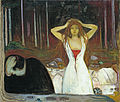Gender struggle. Franz von Stuck to Frida Kahlo

Gender struggle. Franz von Stuck to Frida Kahlo is the title of an exhibition that was shown from November 24, 2016 to March 19, 2017 at the Städel Museum in Frankfurt am Main . Those responsible for the exhibition wanted to examine how the change in gender roles from the beginning of the first women's movement in the 19th century to the end of World War II was reflected in art , concentrating on the art styles of symbolism and surrealism . The exhibits, over 150 paintings, photographs, sculptures and films, came mainly from the museum's holdings and were supplemented by loans. The curators of the exhibition were Felicity Korn and Felix Krämer , heads of the Modern Art Department at the Städel.
Exhibited works
painting
| she |
|---|
| Gustav Adolf Mossa , 1905 |
| Oil and gilding on canvas |
| 80 × 63 cm |
| Musée des Beaux-Arts, Nice
Link to the picture |
The exhibition featured famous masterpieces from the Städel museum holdings, including those by Franz von Stuck , Edvard Munch , Otto Dix , Lovis Corinth and Max Liebermann . The two paintings Salomé by Jean Benner and Sie by Gustav-Adolf Mossa were used as the logo . The latter shows a femme fatale , enthroned on a mountain of her corpses with the blood of her male victims on her thighs. Your gender is hidden by a cat. The curator of the exhibition, Felix Krämer, commented on the works in a conversation with Deutschlandradio Kultur : “What we see in the pictures is an ambivalence. Well, men are fascinated by women. There are many, so to speak, erotic representations in the exhibitions. But - partly, I think, rather unconsciously - this fear, this fear of the dominant, strong and beautiful woman always shines through. "
In the 19th century there were only a few female artists who made the issue of gender relations the subject of their art. Few artists were therefore represented in the exhibition, including Frida Kahlo , Hannah Höch , Jeanne Mammen , Elfriede Lohse-Wächtler and Suzanne Valadon . The latter painted herself and her lover, André Utter, who was 20 years younger than Adam and Eve . Both reach for the forbidden fruit together. Meret Oppenheim has been considered with My Nanny .
John Collier : Lilith (1852)
Felicien Rops : La tentation de Saint Antoine (1878)
Edvard Munch : Ashes (1895)
Max Liebermann : Simson and Delila (1902)
Suzanne Valadon : Adam and Eve (1909)
Franz von Stuck : Adam and Eve , (detail, around 1920)
Sculptures
Among the sculptures on display was a representation of Pythia , the priestess of the Oracle of Delphi , whose prophecies, inspired by hallucinogenic odors, were interpreted by priests. The advice to the Attic League to protect themselves from the Persians with wooden walls is known, which was understood as an invitation to build triremes , with the help of which the Persian fleet was wiped out. The statue is one of numerous copies of the main work of the Swiss painter and sculptor Marcello . Behind the pseudonym is the Countess Adélaïde Nathalie Marie Hedwige Philippine d'Affry, who, since she did not have the advantage of training at the PAFA under the reform approach of Eakins , and therefore could not study nude models, used casts of her own body as a template .
The tennis player was able to practice the sport because she was no longer subject to the restrictive dress code of the past.
Other versions or casts of the sculptures shown in the exhibition can be seen in the gallery:
Marcello : Phytia (1870)
Emmanuel Frémiet : Gorille enlevant une femme (1887)
Laurent Marqueste : Persée et la gorgone (1890)
Franz von Stuck : Amazone (before 1928)
Constantin Starck : tennis player (1930)
Movies
The exhibition included screenings of various films, particularly from the pre-code era.
reception
Art made the exhibition a cover story with the headlines “Unfortunately, cool!”, “Pictures of lust murder are the climax of misogyny” and “The grotesque US election campaign was the total gender war”. The art newspaper spoke of a multi-faceted parade that spanned 100 years. The Handelsblatt highlighted the juxtaposition of first-class works of art history with sultry, perfumed pictures from the second row. The FAZ noted that thetiming of the exhibition was appropriatefor the enthronement of Donald Trump . The works are "a chronological collection of stereotypes, ideal images and figures of identification from a time of great change ... The woman alternating between femme fatale, whore and saint", summarized Die Zeit and criticized that "the artistic reflection on male role models" is missing, even if the title and the makers actually suggested otherwise.
literature
-
Felix Krämer (Ed.): Gender struggle. Franz von Stuck to Frida Kahlo. Städel Museum. Prestel, Munich 2016, ISBN 978-3-7913-5572-6 .
- English-language edition: Felix Krämer (Ed.): Battle of the sexes. Franz von Stuck to Frida Kahlo. Prestel, Munich, London, New York 2016, ISBN 978-3-7913-5573-3 . Translator: Cynthia Hall.
- Gender struggle. Franz von Stuck to Frida Kahlo. An introduction to the exhibition. Städel Museum, booklet.
Web links
- Exhibition website
- Digitorial for the exhibition
- Press text with images
- Promo video on the gender battle on YouTube
- #LetsTalkAboutSexes - the contributions to the social media campaign February 10, 2017, Sarah Omar
Individual evidence
- ↑ The painter's fear of the strong woman. Felix Krämer in conversation with Anke Schaefer , Deutschlandradio Kultur, 23 November 2016
- ^ Art, December 2016, cover story, pages 14-16
- ↑ Kunstzeitung, February 2017, Eva in Munchs Wald, Frankfurt am Main: “Gender struggle” in the Städel, Doirothee Baer-Bogenschütz
- ↑ Handelsblatt, January 27, 2017, Deadly Rivals, Regine Müller
- ↑ Frankfurter Allgemeine Zeitung, January 30, 2017, suddenly at the mercy of someone else, zet.
- ↑ Städel Museum examines gender roles. Im Spiegel der Kunst , Zeit Online, November 23, 2016













